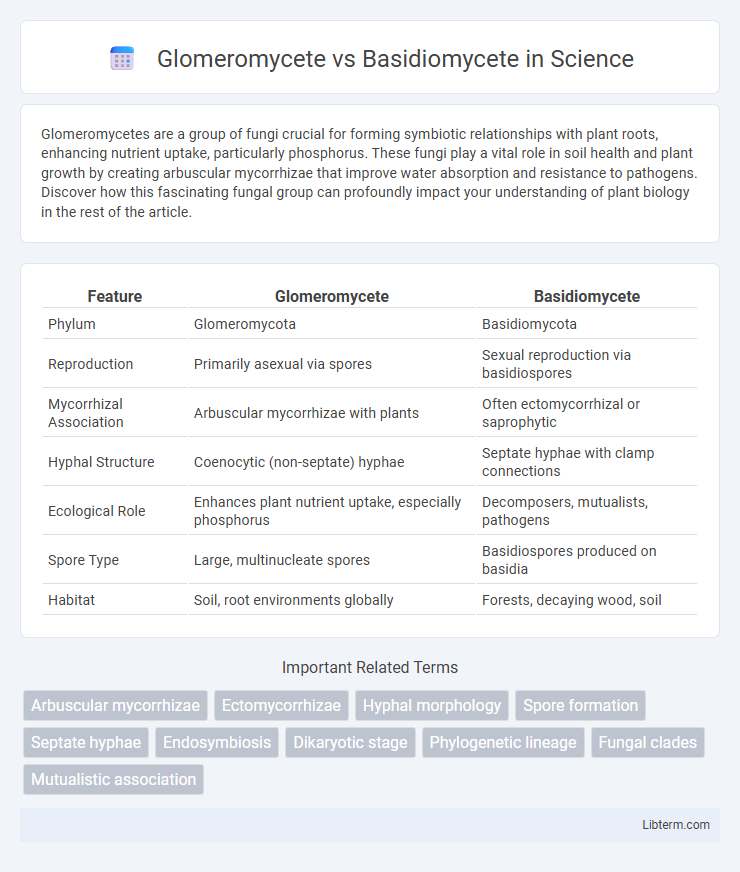Glomeromycetes are a group of fungi crucial for forming symbiotic relationships with plant roots, enhancing nutrient uptake, particularly phosphorus. These fungi play a vital role in soil health and plant growth by creating arbuscular mycorrhizae that improve water absorption and resistance to pathogens. Discover how this fascinating fungal group can profoundly impact your understanding of plant biology in the rest of the article.
Table of Comparison
| Feature | Glomeromycete | Basidiomycete |
|---|---|---|
| Phylum | Glomeromycota | Basidiomycota |
| Reproduction | Primarily asexual via spores | Sexual reproduction via basidiospores |
| Mycorrhizal Association | Arbuscular mycorrhizae with plants | Often ectomycorrhizal or saprophytic |
| Hyphal Structure | Coenocytic (non-septate) hyphae | Septate hyphae with clamp connections |
| Ecological Role | Enhances plant nutrient uptake, especially phosphorus | Decomposers, mutualists, pathogens |
| Spore Type | Large, multinucleate spores | Basidiospores produced on basidia |
| Habitat | Soil, root environments globally | Forests, decaying wood, soil |
Introduction to Glomeromycetes and Basidiomycetes
Glomeromycetes are a group of fungi characterized by forming arbuscular mycorrhizal associations with plant roots, facilitating nutrient exchange and improving plant growth. Basidiomycetes, comprising mushrooms, puffballs, and shelf fungi, are distinguished by producing sexual spores on basidia and play crucial roles in decomposing organic matter and nutrient cycling. Both groups are essential in ecosystems but differ fundamentally in their reproductive structures and ecological functions.
Taxonomic Classification and Evolution
Glomeromycetes belong to the phylum Glomeromycota, characterized by forming arbuscular mycorrhizal associations with plants, while Basidiomycetes are members of the phylum Basidiomycota, known for producing basidia and often complex fruiting bodies like mushrooms. Evolutionarily, Glomeromycetes are considered ancient fungi with symbiotic relationships dating back over 400 million years, playing a crucial role in plant terrestrialization. In contrast, Basidiomycetes exhibit more recent diversification, with advanced reproductive structures and greater ecological niches including decomposers, mycorrhizal partners, and pathogens.
Morphological Differences
Glomeromycetes exhibit arbuscular mycorrhizal structures with coenocytic hyphae lacking septa, while Basidiomycetes possess septate hyphae and form complex fruiting bodies called basidiocarps. The spores of Glomeromycetes are typically large, globose, and thick-walled, contrasting with the often diverse, ornamented basidiospores produced externally on basidia in Basidiomycetes. These morphological distinctions are crucial for their ecological roles, with Glomeromycetes primarily forming symbiotic relationships with plant roots and Basidiomycetes involved in decomposition and nutrient cycling.
Reproductive Strategies
Glomeromycetes primarily reproduce through asexual spores called glomerospores, forming symbiotic relationships with plant roots to facilitate nutrient exchange. Basidiomycetes exhibit complex sexual reproduction involving basidia, where karyogamy and meiosis produce genetically diverse basidiospores. These reproductive strategies highlight Glomeromycetes' reliance on stable mutualism and Basidiomycetes' adaptation for dispersal and genetic variation in various environments.
Ecological Roles and Symbiosis
Glomeromycetes play a crucial ecological role by forming arbuscular mycorrhizal associations with over 80% of terrestrial plants, facilitating nutrient exchange and enhancing plant phosphorus uptake. Basidiomycetes contribute significantly to ecosystem functioning through their roles as decomposers of lignin and cellulose, and as mycorrhizal partners, especially ectomycorrhizal fungi associated with forest trees. Both groups influence nutrient cycling, but Glomeromycetes primarily support plant nutrition in herbaceous environments whereas Basidiomycetes dominate woody habitats and organic matter decomposition.
Mycorrhizal Associations
Glomeromycetes form arbuscular mycorrhizal associations with plant roots, facilitating nutrient exchange primarily through intracellular fungal structures called arbuscules. Basidiomycetes establish ectomycorrhizal relationships characterized by a fungal sheath surrounding root tips and a Hartig net facilitating nutrient transfer. These distinct mycorrhizal types play crucial roles in plant nutrient uptake, soil health, and ecosystem functioning.
Life Cycle Comparison
Glomeromycetes form symbiotic arbuscular mycorrhizae with plant roots, characterized by a relatively simple life cycle involving asexual spore germination and hyphal growth without a known sexual phase. Basidiomycetes exhibit a complex life cycle with distinct sexual reproduction stages, including plasmogamy, karyogamy, and meiosis, producing basidiospores on specialized structures called basidia. The contrasting reproductive strategies influence their ecological roles, with Glomeromycetes primarily enhancing nutrient uptake in host plants and Basidiomycetes contributing to decomposition and nutrient cycling.
Economic and Agricultural Importance
Glomeromycetes form arbuscular mycorrhizal associations with 80% of terrestrial plants, significantly enhancing nutrient uptake and crop yields, thereby promoting sustainable agriculture. Basidiomycetes include economically vital species such as edible mushrooms (Agaricus bisporus) and decomposers that recycle nutrients in agroecosystems, supporting soil health. Both groups contribute to ecological stability, with Glomeromycetes improving plant resilience and Basidiomycetes enabling organic matter breakdown essential for fertile farmland.
Genomic and Molecular Insights
Glomeromycetes possess highly conserved genomes with few species sequenced, revealing unique genes responsible for arbuscular mycorrhizal symbiosis and an ancient origin distinct from other fungi. Basidiomycetes exhibit larger, more complex genomes with diverse gene families linked to lignocellulose degradation, pathogenicity factors, and intricate mating type loci. Genomic studies highlight molecular mechanisms in Glomeromycetes driving symbiotic nutrient exchange, whereas Basidiomycetes demonstrate adaptative evolution through gene duplication and horizontal gene transfer, underlining their ecological versatility.
Key Differences and Similarities
Glomeromycetes form arbuscular mycorrhizal associations with plant roots, facilitating nutrient exchange, while Basidiomycetes primarily decompose organic matter and include mushrooms, puffballs, and shelf fungi. Both groups belong to the kingdom Fungi and reproduce via spores, but Glomeromycetes produce asexual spores inside glomerospores, whereas Basidiomycetes generate sexual spores called basidiospores on specialized cells called basidia. Despite their ecological roles differing greatly--mutualistic symbiosis in Glomeromycetes versus saprotrophic and sometimes parasitic lifestyles in Basidiomycetes--they both contribute crucially to nutrient cycling in terrestrial ecosystems.
Glomeromycete Infographic

 libterm.com
libterm.com